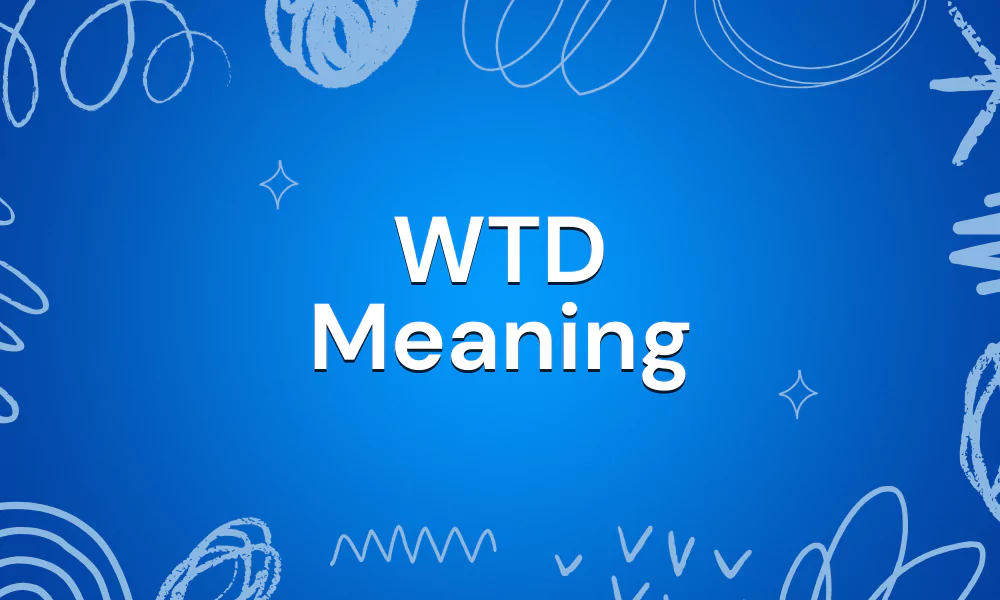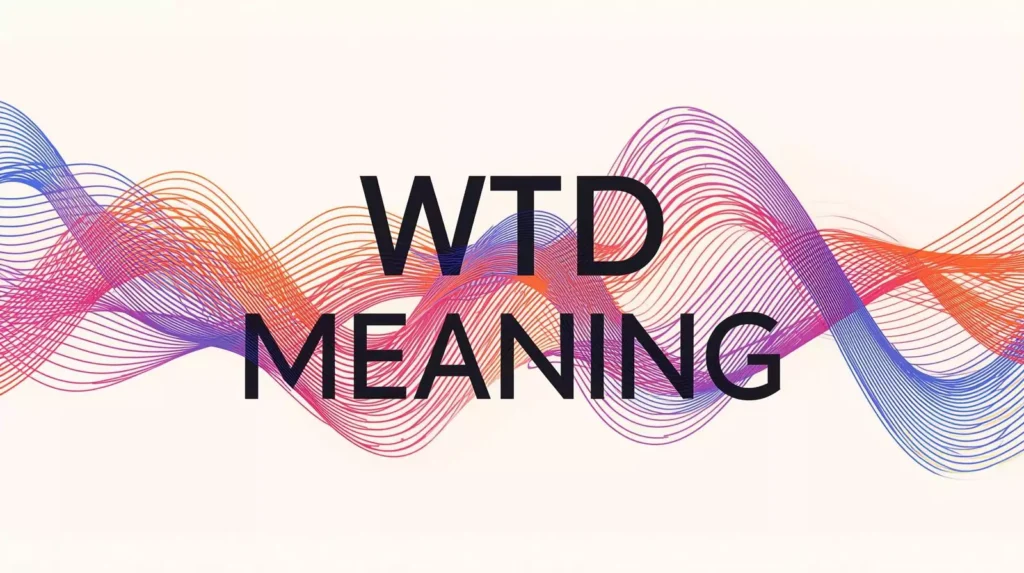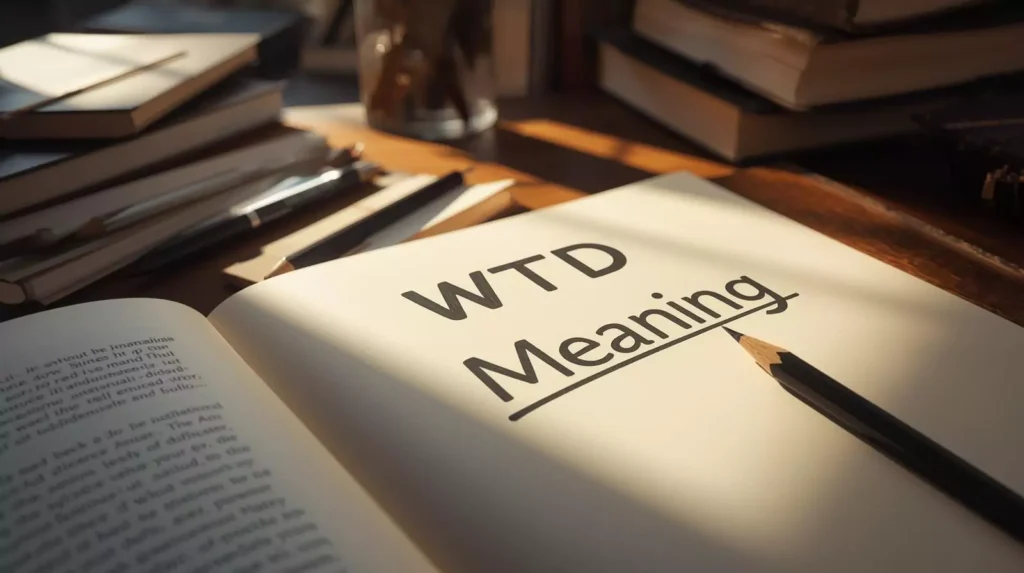WTD Meaning: What Does WTD Stand For in Text and Online?

In today’s fast-paced world of digital communication, acronyms and abbreviations dominate texting, social media, and even casual emails. One such acronym you may have come across is “WTD.” Depending on context, this versatile shorthand can mean “What To Do,” “What’s The Deal,” or even the old-fashioned “What The Deuce.” From expressing confusion or surprise to simply checking in with friends, WTD has become a common part of online conversations across platforms like Snapchat, Instagram, and TikTok. However, its meaning isn’t always the same, which makes context crucial.
What Does WTD Mean?
WTD is a popular internet acronym that can carry multiple meanings depending on the context. The most common interpretations are “What To Do” (used when someone is confused, bored, or seeking advice) and “What’s The Deal” (used to ask what’s happening or going on). In some cases, it’s also used as “What The Deuce” which is a softer, old-fashioned alternative to “What the hell.” Its versatility makes it a go-to phrase in casual digital conversations.

Origins and Evolution of WTD
The abbreviation WTD first appeared in online chatrooms and texting during the early 2000s, when short forms became popular to save time and characters. Over the years, its meaning expanded from a simple “What To Do?” to broader uses like “What’s The Deal?” With the rise of Snapchat, Instagram, and TikTok, WTD evolved into a multi-purpose slang term that expresses curiosity, surprise, or even boredom. Today, it’s a staple of digital shorthand across both casual and social platforms.
WTD in Texting and Chat
In texting, WTD is often used in two main ways:
- To seek advice or suggestions: “I’m stuck at home all weekend… WTD?”
- To check in casually: “Hey, haven’t heard from you in a while. WTD?”
Tone plays an important role here. Used with friends, it can be lighthearted or casual; in group chats, it can restart a paused conversation or express curiosity. However, it’s not suited for formal or professional communication.
WTD on Social Media (Snapchat, Instagram, etc.)
On platforms like Snapchat, Instagram, and TikTok, WTD is widely used to express curiosity, confusion, or to ask what someone’s up to. For example, on Snapchat, you might receive “WTD?” as a casual check-in, while on TikTok comments, it could be used humorously to express disbelief at a video. Its adaptability has made it a trending slang term across multiple social platforms, where short and quick expressions are essential for engaging conversations.
Other Possible Meanings of WTD
WTD has broader meanings in different niches:
| Meaning | Context | Example |
|---|---|---|
| What To Do? | Texting, casual chat | “Bored rn… WTD?” |
| What’s The Deal? | Social media, conversations | “He didn’t show up? WTD?” |
| Work To Do | Workplace context | “Sorry, can’t hang. Got WTD.” |
| Want To Do | Expressing interest | “That’s something I WTD in the future.” |
| Week To Date | Finance/business reports | “Revenue is up 10% WTD.” |
Understanding “What To Do?” in Texts
When WTD stands for “What To Do?”, it usually expresses confusion, uncertainty, or boredom. Someone might text “WTD” when they’re unsure about plans, stuck in a situation, or simply looking for suggestions. For example, “I’ve got the whole day free… WTD?” In this sense, it’s less about asking for facts and more about seeking input or ideas.
Understanding “What’s The Deal?” in Conversations
As “What’s The Deal?”, WTD is often used to check in or ask about the latest updates. It can also express frustration, curiosity, or disbelief. For instance, “You’ve been acting quiet lately… WTD?” In conversations, this usage comes across as casual and conversational, similar to asking “What’s going on?” or “What’s happening?”
Why Tone Matters with WTD
The meaning of WTD depends heavily on tone and context. A playful “WTD?” in a group chat might mean “What are we doing today?”, while the same phrase in a heated discussion could imply annoyance or disbelief. Since acronyms strip away vocal tone and facial expressions, understanding the context before using or responding to WTD is crucial to avoid misunderstandings.
Professional and Polite Alternatives to WTD
While WTD is fine for friends, it’s not always appropriate for professional emails, formal chats, or academic settings. In these cases, swapping it with polite or precise alternatives helps maintain clarity and professionalism. For example, instead of “WTD about this project?” you could write “How should we proceed with this project?” These alternatives ensure your communication is clear, respectful, and professional.
12 Formal Alternatives to WTD
Here are polished alternatives you can use in professional or polite settings:
- How should we proceed?
- What steps should be taken?
- What are the next actions?
- How do you recommend moving forward?
- What’s the best course of action?
- How should we handle this?
- What is the appropriate response?
- What are our options here?
- How do we address this situation?
- What approach should we take?
- Could you advise on the next steps?
- How should this be resolved?
Casual Alternatives for Everyday Texts
In informal chats, you can use fun and relaxed alternatives instead of WTD. These make conversations feel more natural and personal:
- “What’s up?”
- “What’s happening?”
- “What’s good?”
- “What are we doing?”
- “Anything new?”
- “What’s going on?”
- “What’s the plan?”
- “What are you up to?”
The Psychology Behind WTD
At its core, WTD reflects human need for quick connection and clarity. People often use it to express confusion, curiosity, or to seek direction in uncertain situations. Its open-ended nature allows for flexible interpretation, making it a useful shorthand in digital conversations where speed matters.
When to Use WTD
- In casual chats with friends
- When feeling bored and looking for suggestions
- To check in on someone casually
- To express light confusion or curiosity
When Not to Use WTD
- In professional or academic settings where clarity and formality matter
- With people who may not understand internet slang
- During sensitive or serious conversations where acronyms could seem dismissive
- In situations requiring polite or respectful language

Responding to WTD in Texts
How you reply depends on the intended meaning: if it means “What To Do?”, you might offer suggestions; if it means “What’s The Deal?”, you might give an update. Reading the tone and context is key before responding.
Casual Reply Examples
- “Not much, just chilling. You?”
- “We could grab some food later!”
- “Haha, same here. Wanna play something?”
- “Nothing new, what’s up with you?”
Professional Reply Examples
- “Here’s the next step we should take…”
- “I recommend moving forward with option B.”
- “The issue has been resolved. Would you like me to share details?”
- “Let’s schedule a quick call to discuss further.”
Read: MYF Meaning
FAQs
Conclusion
The acronym WTD may seem simple, but its meaning depends heavily on context, tone, and platform. Whether it stands for “What To Do” when you’re bored or confused, “What’s The Deal” when checking in on friends, or even the old-fashioned “What The Deuce” to show surprise, it’s a versatile piece of digital shorthand. While WTD works well in casual conversations and social media chats, it’s not suitable for professional or serious communication. Knowing when and how to use it helps you communicate more clearly, avoid misunderstandings, and match the tone of the situation.
